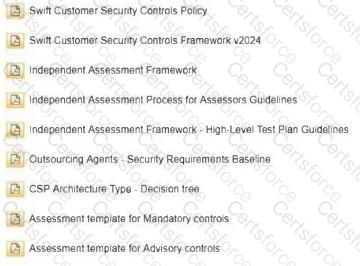This question compares the SWIFT footprint (components within the CSP scope) across different infrastructures:
Step 1: Define SWIFT Footprint
The SWIFT footprint includes all systems and components handling SWIFT messaging or connectivity, as defined in CSCF Control 1.1 – SWIFT Environment Protection.
[Reference: CSCF v2024, Glossary – SWIFT Footprint., Step 2: Analyze Options, A. Full stack of products up to the Messaging Interface: Includes back-office, middleware, and Messaging Interface (e.g., Alliance Access). Large footprint., B. Alliance Remote Gateway: Communication Interface only (e.g., connects to SWIFT via a remote hub). Smaller than a full stack but still significant., C. Alliance Lite2: Cloud-based solution with minimal local infrastructure (just a client application or API). Smallest footprint., D. Full stack of products including IPLA: Includes Messaging Interface plus Interface Payment Link Application (IPLA), expanding the footprint beyond A., Step 3: Compare Footprints, Alliance Lite2 (C) has the smallest footprint, as it’s a lightweight, cloud-hosted solution requiring minimal on-premises components (e.g., a PC or API client). Full stacks (A, D) and Remote Gateway (B) involve more local infrastructure., Reference: SWIFT Product Documentation – Alliance Lite2; CSCF v2024, Control 1.1 Scope., Conclusion: C (Alliance Lite2) has the smallest SWIFT footprint due to its minimal local presence., Reference: SWIFT Alliance Lite2 Overview; CSCF v2024., ]

Submit